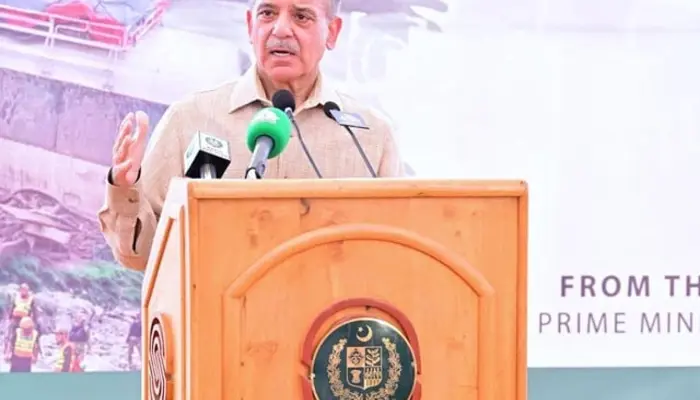As climate-resilient infrastructure takes center stage, Prime Minister Shehbaz Sharif has directed authorities to urgently generate funds for rebuilding Pakistan’s vulnerable regions. His call came after monsoon rains since late June claimed over 300 lives, highlighting the country’s increasing exposure to extreme weather.
Visit to Flood-Hit Gilgit
On Monday, Shehbaz Sharif arrived in Gilgit, one of the worst-hit areas in northern Pakistan, to lead a high-level review of the flood damage. His visit included meetings with senior government officials and ministers to assess the situation and plan relief measures. According to the Prime Minister’s Office, he also met with victims of rain-related incidents and distributed financial aid.
The visit underscores growing concern about Pakistan’s lack of preparedness against worsening climate events. Sharif’s appeal to the climate change ministry focused on securing funds to build durable, flood-resistant infrastructure.
Country Faces Mounting Climate Threats
Pakistan, despite contributing less than one percent to global greenhouse gas emissions, remains one of the most climate-vulnerable countries. It is home to over 7,000 glaciers and frequently endures severe weather swings. In recent years, it has suffered through historic heatwaves, prolonged droughts, and devastating storms.
During the Gilgit meeting, Sharif voiced frustration with the lack of tangible results from international climate conferences. “Many conferences are held worldwide regarding climate change,” he said. “Officials have attended several meetings. Now they should generate funds to make our infrastructure climate-resilient.”
Read: The Worst Tsunamis the World Has Ever Seen
Grim Statistics Emerge
The National Disaster Management Authority (NDMA) released updated figures on the human toll of this year’s monsoon season. Since June 26, a total of 300 people have lost their lives in rain-related incidents. Of the victims, 140 were children, 103 were men, and 57 were women.
Punjab has suffered the highest number of deaths at 162, followed by Khyber Pakhtunkhwa (KP) with 70. Sindh has recorded 28 fatalities, Balochistan 20, Gilgit-Baltistan 10, Islamabad eight, and Azad Kashmir five.
This widespread impact highlights the scale of the crisis. Many of these regions are underdeveloped, lacking proper drainage systems and emergency response infrastructure.
More Rain on the Horizon
Adding to the urgency, the Pakistan Meteorological Department (PMD) has warned of further heavy rains beginning August 4. According to the forecast, monsoon currents are expected to strengthen, increasing the risk of flash floods and landslides.
The PMD issued alerts for several vulnerable areas including Chitral, Swat, Dir, Shangla, Kohistan, Mansehra, and Abbottabad in KP, as well as Murree, Galliyat, Islamabad/Rawalpindi, northeast Punjab, and Kashmir. The forecast, covering August 5 to 7, warns that heavy rain could trigger landslides and mudslides, potentially closing roads and cutting off entire regions.
Authorities have been urged to remain on high alert and prepare for possible evacuations, especially in hilly and flood-prone regions. Residents have also been advised to avoid travel in vulnerable areas during peak rainfall.
Recurring Disasters Demand Urgent Action
Pakistan’s recurring climate disasters have forced its leaders to rethink national priorities. In May, severe storms killed 32 people. In 2022, the country faced catastrophic floods that submerged a third of its landmass, killed over 1,700 people, displaced more than 30 million, and caused an estimated $35 billion in damage.
Despite multiple rounds of international aid and promises of climate financing, little has changed on the ground. Infrastructure remains fragile. Relief operations are often delayed. Rural areas remain especially vulnerable.
Sharif’s latest push could mark a turning point if followed by concrete action. He emphasized the importance of not just discussing climate threats, but actively investing in solutions that protect lives and communities.
A Race Against Time
As the sixth monsoon spell gains strength, the window for action is rapidly narrowing. Experts agree that without climate-resilient infrastructure, future floods will bring even greater devastation.
Sharif’s directive to mobilize funding must now be met with swift planning and execution. For Pakistan, survival in the age of climate change is no longer about weather forecasts — it’s about readiness.
